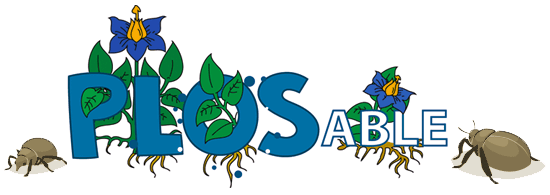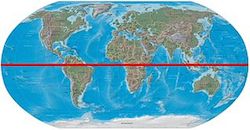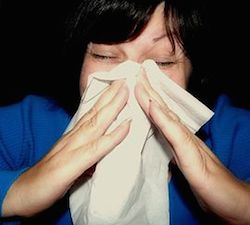
Trouble in the Tropics
What's in the Story?

It's a warm evening at summer camp, and you're on your way back from a long hike. All around you the kids are complaining about the heat. Even worse is that mosquitoes are flying around biting everyone’s ankles. At dinner everyone counts the bug bites they got on the hike. You discover three mosquito bites – on your elbow, your knee, and your shin – and you try to remember not to scratch them.
Later, you are lying in bed in the hot, humid night. Sweating, you wish you could just fall asleep. You start counting sheep and finally start to relax. You’re just drifting off when – argh! – you hear the whine of a mosquito next to your ear.
Why are there so many mosquitoes around in summer, when you hardly ever see them in the winter? Many bugs really seem to love warm weather. Because bugs generally prefer warmer weather, there end up being a lot more bugs in places with warmer climates.

Unfortunately, some of these bugs can spread disease to the people that they bite. In the PLOS Biology article “Disease Ecology, Biodiversity, and the Latitudinal Gradient in Income” scientists studied how the spread of disease caused by bugs and parasites changes in different climates and how this affects humans.
Bugs Around the World
In the Arctic and the Antarctic, it is very cold all year round. Because of this, not many plants or animals can survive. This means that the biodiversity in these places is pretty low. But closer to the equator, the climate is much warmer. This means that many more organisms are able to live there. Countries near the equator, like Brazil and Costa Rica, have very high biodiversity.

High biodiversity also means there are more bugs. The warm, wet tropics create an environment that is perfect for bugs to lay their eggs. Also, there are lots of other kinds of animals living in these areas on which bugs can feed. This is important because many of these bugs, like mosquitoes, eat by sucking blood from other animals.
How Bugs Can Make You Sick
Unfortunately, some of these bugs can carry diseases, like malaria or Lyme disease. This can happen when they feed from a human or animal that already has a disease. If they then bite another human or animal, they can spread the disease.
A disease that can be carried by bugs or other animals and spread to humans is called a vector-borne disease. If tropical areas have a lot of bugs, vector-borne diseases can spread faster than in other areas with less bugs. This means that more people might become infected.
Making Connections

At the same time, scientists noticed that people who lived in these tropical areas tended to have lower incomes. This meant that a person living in an area with a warmer climate was likely to make less money than someone living in a cooler climate. Scientists thought there might be a connection between living in a place with more disease-spreading bugs and having a lower income.
Many different scientists began asking questions about income, climate, and disease. Some did research and found that people in tropical climates had lower incomes because of the climate itself. Other scientists thought that maybe people in tropical climates carried more disease than less tropical countries throughout history, and so income remained lower over the years.
Meanwhile, other scientists were doing lots of research on bugs that spread disease. This included studying the bugs, as well as what happens to bugs in places with more or less biodiversity. However, none of these groups had looked at climate, bugs, and disease together. It was as if each group of scientists had studied a smaller piece of this puzzle, but no one had studied all of the pieces together. But how could they possibly combine all these pieces to see the whole picture of what is happening to people in the tropics?

Putting Together the Puzzle
What if disease, climate, bugs, and income together could help explain what was happening in the tropics? In this experiment, scientists found all the articles that had been written about biodiversity, disease, climate, and income. They combined the data from all of this research in a statistical model so they could study it together. This model allowed the scientists to understand the relationship between all of these factors in different regions around the world.
The model gave scientists two main results. First, they found out that tropical places with higher biodiversity had more disease-spreading bugs. Where there were more bugs that could spread disease, people were sick more often. Second, scientists found that people who lived in these tropical areas where disease-spreading bugs were more common were more likely to have lower incomes.
Being Sick Can Make You Poorer

When people in the tropics are sick all the time, they can't work as hard. Think about the last time you were sick – did you get to stay home from school? Do you think you could have paid attention in class if you felt like you were going to be sick? The same thing happens when adults feel sick. Sometimes they have to stay home from work and they don’t feel good enough to do their best work. Then, they make less money because they can't work as much. In the end, a whole country can end up poorer if they have too much disease.
Biodiversity and Disease-Spreading Bugs
Scientists found that areas with higher biodiversity also had more bugs, and these bugs were linked to more disease and lower income. Importantly, their statistical model also reported an interesting pattern related to biodiversity. When a place with high biodiversity loses some of its plant or animal species – for example, if trees are cut down in a forest and some of the animals can no longer live there – biodiversity decreases. You might think this should reduce the disease problem since disease and high biodiversity were linked. But actually, the opposite happens.
As biodiversity in tropical areas decreases, scientists found that the bugs that spread disease seemed to become more of a problem. A decrease in biodiversity may make it so these bugs have fewer other animals to feed on, and they may tend to bite humans more often. This can increase the spread of disease to humans and may be a reason why income is lower in these tropical regions.
So one of the best ways to stop disease-spreading bugs from taking over the tropical environment is to protect all the different kinds of plants and animals that live there. In other words, we need to preserve the biodiversity of the tropics. If we do, there may be less sickness from disease-spreading bugs. That’s great news for people and the environment.
Additional images via Wikimedia Commons. Globe image via SPM. Tropical landscape image via MGA73bot2.
Bibliographic details:
- Article: Trouble in the Tropics
- Author(s): Anika Larson
- Publisher: Arizona State University School of Life Sciences Ask A Biologist
- Site name: ASU - Ask A Biologist
- Date published:
- Date accessed:
- Link: https://askabiologist.asu.edu/plosable/trouble-tropics
APA Style
Anika Larson. (). Trouble in the Tropics. ASU - Ask A Biologist. Retrieved from https://askabiologist.asu.edu/plosable/trouble-tropics
Chicago Manual of Style
Anika Larson. "Trouble in the Tropics". ASU - Ask A Biologist. . https://askabiologist.asu.edu/plosable/trouble-tropics
Anika Larson. "Trouble in the Tropics". ASU - Ask A Biologist. . ASU - Ask A Biologist, Web. https://askabiologist.asu.edu/plosable/trouble-tropics
MLA 2017 Style

Be Part of
Ask A Biologist
By volunteering, or simply sending us feedback on the site. Scientists, teachers, writers, illustrators, and translators are all important to the program. If you are interested in helping with the website we have a Volunteers page to get the process started.
